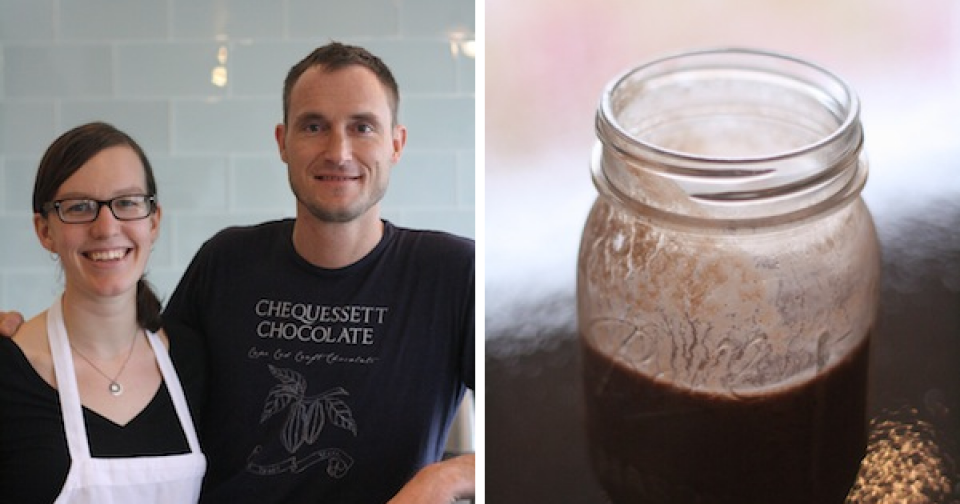Katie Reed and Josiah Mayo don’t make your typical mass-produced chocolate.
“80% of all the cacao that is grown in all the world is grown on the West Coast of Africa the variety that’s grown in Western Africa is disease resistant and has a high yield but has a very uninteresting flavor profile,” Katie says. “And we chose to work with farms using a direct trade model in Central America to reclaim some really interesting heirloom cacao varieties that are being grown.”
Different varieties are good for different things — Katie and Josiah like a cacao from Belize best for drinking chocolate, but they prefer another variety for their bars.
“So here we have a bag of oko-caribe beans from the Dominican Republic. You can smell that strong acetic acid that we were talking about here. Our job as chocolate makers is to remove this flavor just to the extent that we’re retaining a little bit so that the chocolate has a bright and fruity kind of redberry characteristic,” says Katie.
The process starts by spreading the beans on a sheet pan and roasting them in the oven. Next Katie and Josiah crack the beans and separate the shells from the cacao nibs. The nibs move on to a machine that will grind them down using two hundred pounds of granite. Josiah explains.
“This is the machine we use to grind our nibs into a very silky liquid as you can see.”
It’s starting to look a little bit more like the chocolate that we eat.
“The beans are 54% cocoa butter content so they’re very high in fat, the good kind of fat, but all you need is a little bit of heat and agitation, so even though this looks like liquid chocolate there’s no sugar that’s actually been added yet,” says Katie. She adds, “but this is the cacao liquor here and then later today we’ll add the sugar and spin it for a couple more hours before we then begin to conche the chocolate and get those finish flavors.”
Conching is a process discovered by Rodolphe Lindt of the famous Lindt chocolate. The basic idea is to aerate the liquid chocolate with a mixer until most of the acids gas off and the cocoa fats are distributed evenly.
Next Katie and Josiah do something called tempering. Chemically, chocolate is composed of six crystals. To keep the cocoa butter evenly distributed at room temperature and give the bars that nice gloss and snap we look for, the crystals need to be heated up to between 88 and 91 degrees Fahrenheit.
“If anyone’s familiar with tempering at home it can be a very imprecise process. This we can put warm chocolate in this bowl here and as it comes out this augur this pump here it’s cooling the chocolate down and coming out tempered so it’s a miraculous piece of equipment that allows me to make hundreds of bars a day and really makes it a lot more scientific and exacting and predictable,” says Katie.
The chocolate pours out of the tempering machine in perfect 2 ounce doses, each of which fill a bar-shaped polycarbonate mold. Katie and Josiah cool the bars for 10-15 minutes in a fridge to let them set up. Then they wrap each one by hand in foil and paper, and finally either distribute them to other local stores or sell them on site.
“When we got into this we had a hunch and there was conventional wisdom that good chocolate was good for you and it’s been really surprising and delightful to see all the coverage in the media,” Josiah added.
Recent studies have shown the anti-oxidants in minimally processed chocolate can help fight heart disease, produce happier babies, and even ward off Alzheimers. Heavily processed chocolate — especially chocolate that’s been Dutch processed — can have up to 90% fewer anti-oxidants. Katie says learning about the natural variations in cacao beans and the finished product are what made her and Josiah want to start making their own bars.
“Chocolate is such a ubiquitous food and as the local food movement grows I felt like it was one of these foods where we weren’t really considering where it came from and how it was made. And upon traveling with Josiah to source our cacao we visited all these incredible farms and to see the actual tree growing and producing the fruit and the whole process of how the farmer gets it ready to be turned into chocolate was just incredibly fascinating and compelling and we wanted to bring that to the Cape and share that with people.”
The bean to bar chocolate movement is on the rise — small batch manufacturers are cropping up all over New England.
—
Here is a link to Elspeth’s favorite chocolate bundt cake recipe.
Here are links to some of Elspeth’s other favorite small-scale producers:
This piece first aired in 2014.


